Ferry Crossing to Orkney
I grabbed onto the sturdy arm of a total stranger, and stuck to him like a barnacle on the belly of a whale. - Five minutes of hair-raising travel
The sea off of Scotland’s far north is running only slightly higher than normal this morning, but I grabbed onto the sturdy arm of a total stranger, and stuck to him like a barnacle on the belly of a whale.
My face was approaching the color of wallpaper paste. “Och, it’s a fine day for crossin’ ,” he’d assured me as I boarded the Northlink ferry in Thurso for the nearly three-hour hour trip to Orkney. This lovely, burly man introduced himself as Fergus and reassured me several times, “Hold on, lass, we’re almost there! Nae bother, almost there.” I made a mental note to throw away the return ferry ticket. I will fly back to Inverness next week instead.
** CLICK THREE TIMES on the white arrow. This is not the Northlink ferry that I was on, but you’ll get the picture in 30 seconds…
The prow lifts to a 20˚ angle out of the chop and slams down hard, over and over, sending spray high across the deck. My stomach lurches and threatens to give up its breakfast porridge. I hold tighter to Fergus’ muscular arm. The returning native Orcadians calmly sit and read or chat. The white-knuckled, green-gilled back-packers cling like limpets to the brass rails and poles. The outline of Orkney is visible in the hazy distance at a mere 27 miles, but by my visceral reckoning, it feels more like 270. I’m definitely flying back…
**TURN DOWN THE SOUND! CLICK THREE TIMES..
Orkney is a group of islands off the far north of Scotland. They are flat, green, nearly treeless and monumentally windy. The sea continuously batters the tall sandstone cliffs, carving unusual rock formations. Large colonies of barking seals decorate the seascape. Orkney has been a part of Scotland since 1472, but its roots and its character, even today, are Norse. I have come specifically to visit the ancient graves of my Viking ancestors, to see where and how Orcadians of the neolithic age honored their dead. These islands encompass an incredibly high concentration of stone burial mounds and ritual sites, and shreds of my DNA lie interred in them.
The ferry arrives in Stromness, where I arranged to join a group of six strangers on a minibus; the driver is Martin, a knowledgable, affable, and enthusiastic guide. He’ll take us to explore several archeological areas over the next three days. The wind is so high today, he struggles to keep the wee bus on the narrow roads, all the while telling stories about the history of Orkney and pointing out features of the landscape.
Of the hundreds of archeological sites in the Orkney archipelago, many have been excavated and enhanced to welcome visitors, but most of the tombs, cairns and monuments are, as yet, still unexplored. Several of the places we visit lie within ten miles of each other.
The remains of the stones at Stenness are located in the center of farmland surrounded by sheep. There are four upright stones as tall as 18 feet, part of a circle that originally held twelve huge stones. In the center was a large hearth. The form of the circular ditch and bank has been lost over time due to ploughing. We take photos of each other leaning up against these ancient monoliths to show the scale. We are dwarfed in contrast.
We walk among the enigmatic stones of one of the most spectacular prehistoric monuments in the British Isles. The massive Ring of Brodgar stone circle is an enormous ceremonial site dating back to 3,000 BCE. It originally consisted of 60 stones; only 36 survive today. Also at this site are at least 13 prehistoric burial mounds.
We practically crawl on our hands and knees to enter Maeshowe — a large neolithic chambered burial tomb (third millennium BCE.) In the 12th century, Norsemen broke in and sheltered here. They carved fascinating graffiti into the interior walls, leaving behind one of the largest collections of Norse runes to be found anywhere. Translations of these runic symbols, show them to be very like the graffiti one might find scrawled on walls today, by the young and lustful.
Ingebjork the fair widow - many a woman has walked stooping in here a very showy person" signed by "Erlingr"
"Thorni fucked. Helgi … "
"Ingigerth is the most beautiful of all women" ( carved beside a rough drawing of a slavering dog )
"This mound was raised before Ragnarr Lothbrocks. Her sons were brave smooth-hided men …"
“For a good time, see Thorni”. ( Okay, that is a loose translation, but it’s what it signifies.)
Some of the inscriptions talk of finding treasure here. They show the names of the men, boast of their exploits, and tell ribald jokes. An absolutely delightful experience, not only for the archeology, but for evidence that no matter what era, young men are, well, young men.
The broch at Gurness is a massive, thick-walled stone tower that was used both as a home and as a defensive refuge. The village that grew up around it has been carefully excavated and gives an idea of life between 500 BC and 200 BC. We see that this fortified tower, now fallen, originally had a single central hearth, a ring of stone cupboards around the wall, a sunken water basin, and a set of stairs which led to the upper floors. We tramp over the entire 150-foot settlement, oblivious to the drizzly bluster of wind.
Skara Brae Historic Village, at the edge of the sea, is buffeted today by a wind so violent it is near impossible to walk against it. I am blown over onto my back twice while exploring! Skara Brae is a collection of eight preserved drystone buildings surrounded by sandy soil, and is covered in turf and organized around a central “street.” What remains of these connected dwellings is largely stone, from the structures’ walls, stone dressers, beds, and tanks, but they have also found bone, pottery, and stone jewelry here as well. It appears the inhabitants of Skara Brae were farmers who reared cattle, pigs, sheep, and deer and also fished the seas for cod, haddock, and all manner of shellfish.
Today, after five days of walking and learning about this haunting and haunted landscape, I leave those braver than I, to take the ferry back. I board a small Logan Air flight for the 45 minute hop back to Inverness. It’s been an unforgettable experience, and I plan to return soon, but, for now, I’ve had enough wildness and relentless wind from off the North Sea. Orkney, from the window of our mini-jet on departure, looks like a collection of large green leaves floating on a vast pond.
Note: All the sites mentioned here are found on line for more in-depth study.




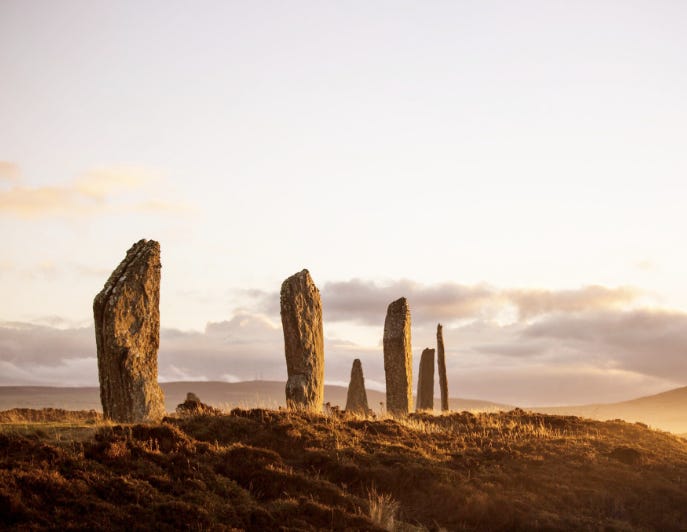
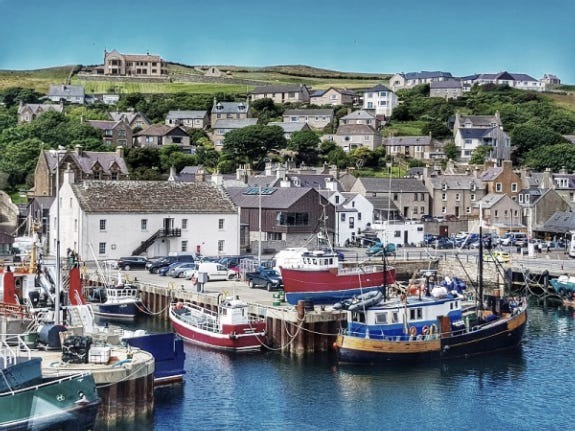
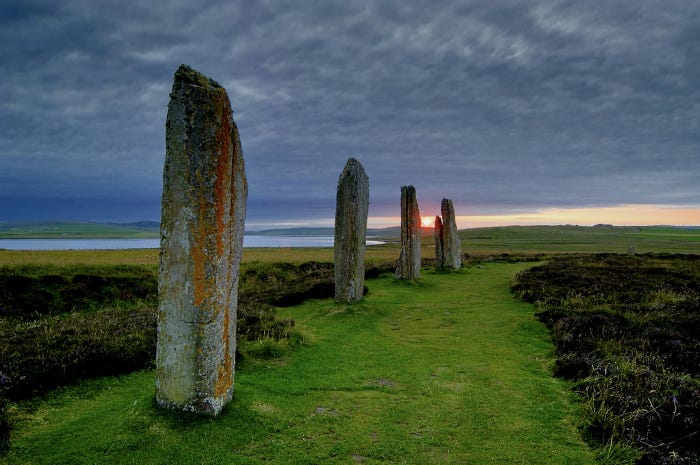
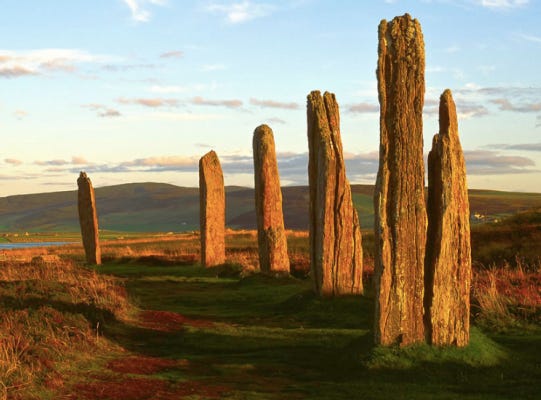
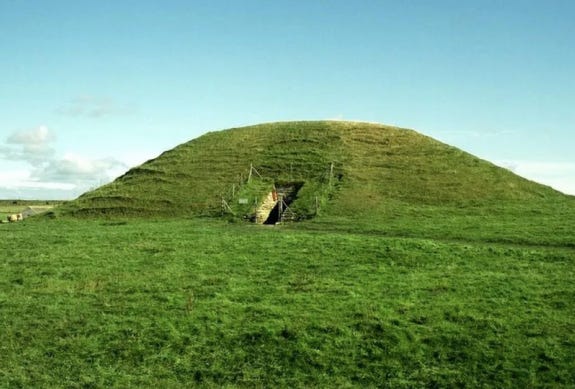


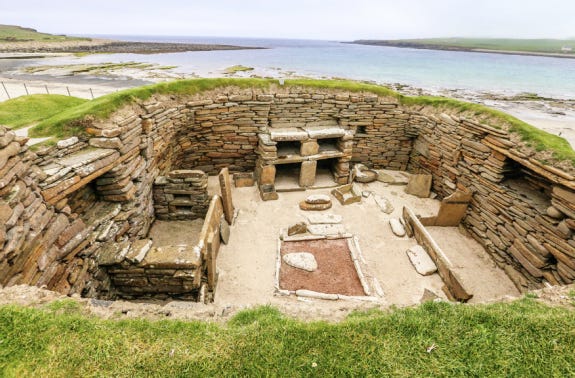


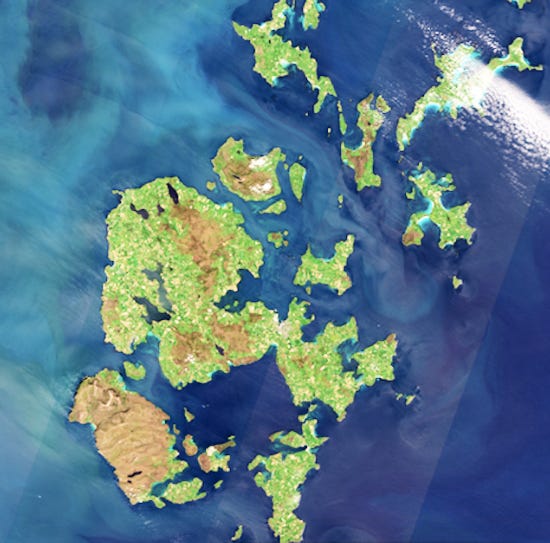

That was fun. My sister-in-laws uncle lived on Orkney, I think he was a researcher. And several years ago, I went to the Shetland islands as part of a cruise. So,a gentler trip, but a wonderful experience.
What a fantastic adventure! I'd love to have gone there but can see the ride over and the wind may be a deterrent to many weak-kneed tourists.